Laboratory Animal Medicine Study Guide
1/67
Earn XP
Description and Tags
Vocabulary flashcards for VET 215 Laboratory Animal Medicine, Summer 2013, Introduction to Laboratory Animal Science
Name | Mastery | Learn | Test | Matching | Spaced |
|---|
No study sessions yet.
68 Terms
AALAS
American Association for Laboratory Animal Science
Role: a professional organization that promotes the humane care and use of laboratory animals through education, training, and advocacy.
APHIS
Animal and Plant Health Inspection Service
Role: a branch of the USDA that oversees the use of animals in research and compiles data submitted by facilities on the number of animals used each year
AWA
Animal Welfare Act
Role: a federal law that governs sale, handling, transport, and use of animals and sets standards of care for animals in education, research, or exhibition
USDA
United States Department of Agriculture
Role: a federal agency responsible for administration and enforcement of the Animal Welfare Act.
AVMA
American Veterinary Medical Association
Role: Promotes health and welfare of all animals
Establishes acceptable euthanasia methods (Report of the American Veterinary Medical Association Panel on Euthanasia)
Parent organization for all veterinarians
Involved with Veterinary Technology Program accreditation (CVTEA)
IACUC
Institutional Animal Care and Use Committee
AAALAC
Association for Assessment and Accreditation of Laboratory Animal Care International
Role: a non-profit organization that promotes the humane treatment of animals in research and education through voluntary accreditation programs.
ACLAM
American College of Laboratory Animal Medicine
Role: a professional organization that certifies veterinarians in laboratory animal medicine and promotes high standards of veterinary care for research animals. Board certifies “Diplomates” through examination
ILAR
Institute for Laboratory Animal Research
Role: a division of the National Research Council that promotes the humane care and use of laboratory animals through education, research, and resource development. writes and updates the guide
NIH
National Institutes of Health
Role: a part of the U.S. Department of Health and Human Services that conducts and funds medical research.
OSHA
Occupational Safety and Health Administration
Role: a federal agency that ensures safe and healthy working conditions by setting and enforcing standards and providing training, outreach, education, and assistance.
The 3 R's in research
Reduction-reduce # animals used
Refinement-refine procedures to minimize stress or pain
Replacement – use cell, tissue culture or models
Give examples of how humans have benefited from laboratory animal research?
Humans have benefited from laboratory animal research through advancements in medical treatments, the development of vaccines, and improved surgical techniques, contributing to overall health and safety.
List the four levels of AALAS certification and be able to describe the roles and/or duties of each.
Assistant Laboratory Animal Technician (ALAT)
Laboratory Animal Technician (LAT)
Laboratory Animal Technologist (LATG)
Certified Manager of Animal Resources (CMAR) or Laboratory Animal Manager
Each level reflects increasing knowledge and responsibilities in ensuring the care and welfare of laboratory animals.
Each require certification examination (1-3 years)
What is the first most commonly used animal in research?
The first most commonly used animal in research is the mouse, recognized for its genetic similarity to humans and rapid reproduction.
What is the second most commonly used animal in research?
The second most commonly used animal in research is the rat, valued for its adaptability and well-defined physiology.
Each phase of the research project requires planned steps:
1.Planning the experiment
2.Writing a proposal
3.Getting approval of the proposal for submission
4.Submission of an Animal Use Protocol (AUP)
5.Funding
6.Setting up the experiment
7.Performing the experiment
AUP
Animal Use Protocol
Role: a formal plan detailing the care and use of animals in research, ensuring ethical standards and regulatory compliance.
IACUC
Institutional Animal Care and Use Committee
Role: a group that oversees research involving use of animals
Must determine if the research requires animals
Determines if care & use are appropriate
Compliance with federal, state, governmental regulations
Must meet at least twice yearly
Inspects facility twice yearly & submits findings to the IO
Addresses concerns of the public
IACUC members
A veterinarian
Scientist experienced in animal research
Person not affiliated with institution
Involuntary regulations
Must be followed by law or to receive funding
Voluntary regulations
Regulations that a research facility chooses to follow
LAS
Laboratory Animal Science
Scientific and technical information and techniques applied to laboratory animal care, governed by regulations, policies, and guidelines.
Initially written to protect dogs and cats from theft
the Animal Welfare Act
The Guide for the Care and Use of Laboratory Animals?
A guide for appropriate standards of care and use of laboratory animals.
Who publishes the Guide for the Care and Use of Laboratory Animals?
The National Academies of Sciences, Engineering, and Medicine.
What animals are covered in the Animal Welfare Act?
The Animal Welfare Act covers all warm-blooded animals used in research, teaching, and testing, with some exceptions, including certain agricultural animals and birds.
What animals are not covered in the Animal Welfare Act?
The Animal Welfare Act does not cover birds, rats, and mice (cold-blooded animals have not been addressed)
Who are members of the research team?
The Principal Investigator (PI)
Co-Investigators
Research Technicians
Laboratory Animal Technicians (LAT)
Laboratory Animal Veterinarian
Lab animal facility administrator
Principal Investigator (PI)
Scientist, usually has a PhD
Plans and coordinates all phases of the research
Writes the proposal; follows protocol; evaluates results for publication.
Not necessarily “hands on”
Co-investigators and Research Technicians
Perform tasks outlined in the protocol (AUP)
Collect and organize generated data
Duties depend on training & ability
Laboratory Animal Technicians
Animal care
Cleaning & sanitation
Husbandry
Feeding
Record keeping
Environment maintenance
Medical treatments/abnormalities
Write and follow Standard Operating Procedures (SOPs)
Understand and follow Animal Use Protocols (AUPs)
Laboratory Animal Veterinarian
Advises PI on appropriate animal to use in the experiment
Coordinates animal care activities
Maintenance of the animal colony health (medical care)
Assures compliance with regulations
Assures compliance with policies and regulations that affect experimental animals
Lab Animal Facility Administrator
Responsible for operation of the facility
Supervises staff
Assures appropriate records are maintained
Know the common areas of a research facility and what they are used for
Animal Rooms
Hallways
Procedure Rooms
Surgical Suite
Cage Washing Rooms
Feed & Bedding Storage
Equipment Storage
Necropsy Laboratory
Personnel Areas
Quarantine & Isolation
Facility Security
Conventional
no special precautions are taken to prevent introduction of disease, single doors open onto a central corridor
Double-Corridor
clean/dirty, rooms have two doors. One door opens onto “clean” corridor, other opens onto “dirty” corridor, unidirectionalntraffic, enter through clean exit through dirty
Barrier
special cages and procedures are used to prevent introduction of disease and/or the escape of disease.
Air pressure carefully monitored
Personnel shower before entering rooms, wear protective clothing
All items entering/leaving room are autoclaved
Animals are SPF(germ free)
Containment
similar to barrier facilities
HEPA filter on room exhaust
Air pressure carefully monitored
Personnel shower when leaving facility
All items entering/leaving building are autoclaved
Houses animals with infectious or zoonotic diseases
Variables in the animal room can impact animal behavior and health
Temperature
Humidity
Ventilation
Light intensity/duration
Noise
Microenvironment
cage
Macroenvironment
room
Ventilation
(air exchange)
Eliminates odors (ammonia)
Reduces airborne microorganisms
Maintains temperature & humidity
The “Guide” recommends air exchange rate of 10-15 exchanges of fresh air/hr
Polystyrene cages
Advantage: inexpensive
Disadvantage: melts/warps at normal wash temps; low/moderate impact strength
Often used as disposable rodent cages
Polypropylene cages
Advantage: good at higher temperatures
Disadvantage: opaque; limits monitoring
Often used as breeding cages & for secretive animals
Polycarbonate cages
Advantage: high impact strength; can withstand high wash
temperatures; transparent; inexpensiveDisadvantage: most expensive of the plastics
Galvanized Steel, iron and wood are not suitable cage materials
– Steel and iron rust
– Wood is porous
Galvanized Steel, iron and wood are not suitable cage materials
– Steel and iron rust
– Wood is porous
Shoebox Cage (Rodent)
Solid bottom plastic cage
Stainless steel lid
“V” shaped trough for feed and water
Snaps securely to prevent escape
Filter top—Controls microenvironment
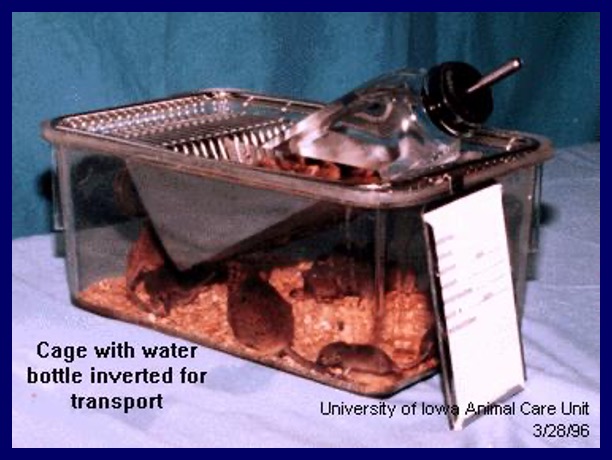
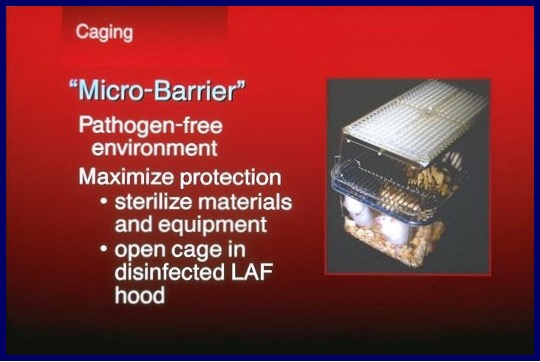
Filter tops
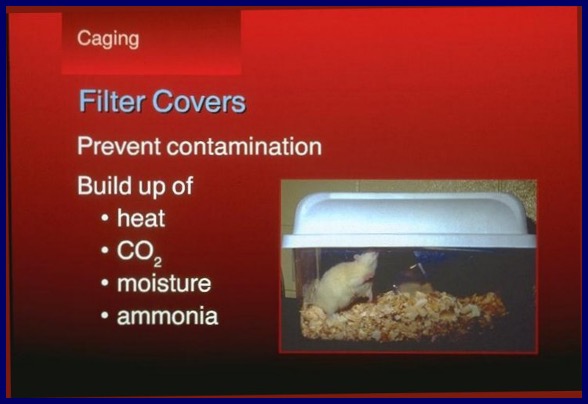
Suspended Cage System
Cage is plastic or wire
Hangs from aluminum or stainless-steel runners on a mobile rack
If cage floor is wire, waste drops into a tray

Metabolism Cage
Designed to collect urine or feces
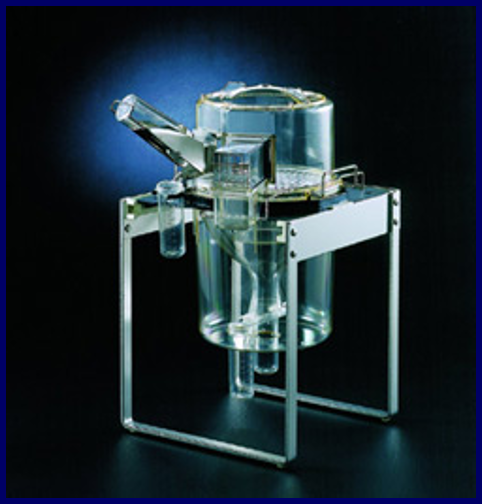
Gang cages
House groups of same species
Can be mobile or stationary
Some contain special resting boards or perches
Food & water in several locations
House cats, primates, sheep, birds
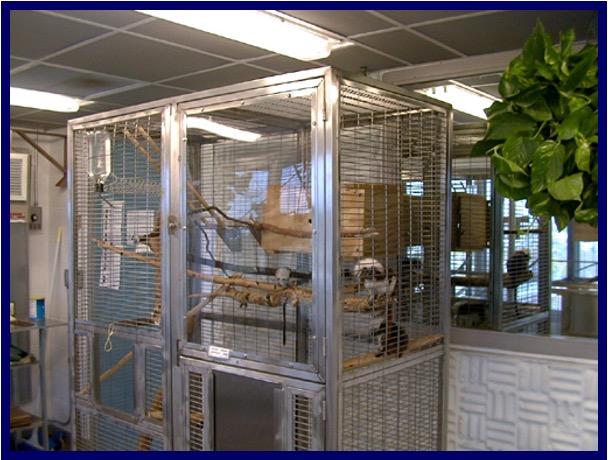
Transport Cages
Move from location to location
Two types
Shipping crate; used by suppliers to ship animals to facilities that will contain food, water, bedding
Portable holding cage – used for movement within the facility. Temporary housing that does not contain food, water, bedding.
Handheld or on wheels

Activity cages
Provides exercise for animal
May contain exercise wheels, swings, jungle gyms, etc.
Inhalation Cages
Enclosed chamber
Strict control over environment
Recovery cages
Similar to ICU cages
Can control temp, humidity, oxygen pressure, etc.
Automatic system for water
Advantage
Filters can be used in the line
Decrease staff time
Automatic system for water
Disadvantage
Can’t monitor water consumption
Expensive
Requires close monitoring (pressure valves, gauges)
Animals must learn how to use
EX
Any animal not bred by dealer must undergo a 5-10 day waiting period to verify origin before selling or transferring to another facility.
Purpose Bred
animals specifically bred for research or testing purposes.
Conventional
Animals having unknown microflora
Sentinel animal
Method of monitoring quality assurance, they are susceptible to particular pathogens. Periodically testing is performed on them to identify presence of microorganisms in the animal colonies.
Gnotobiology
The study of animals with completely known flora and fauna minimizes variables in research
Axenic
“without strangers”, germ free, must be maintained in barrier facilities, food and water must be sterilized, which subsequently results in need for heavy supplementation of vitamins and minerals. Grow faster; absorb fat better, longer life span.
Gnotobiotic
Have well defined microflora, only microorganisms specified are present
Specific Pathogen Free
(SPF) Free of certain specified pathogens, all other microflora is unknown
Cesarean Derived
Animals delivered by cesarean section to ensure they are free from maternal pathogens, often used to establish gnotobiotic colonies.
Barrier-Sustained
Derived by c-section and then maintained in sterile, controlled, barrier environment. All supplies food, water, and equipment must be sterilized before introducing. Must keep animals from being contaminated with pathogens